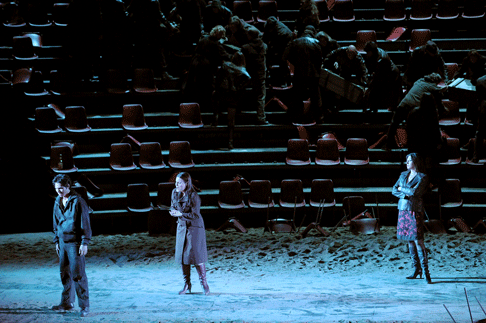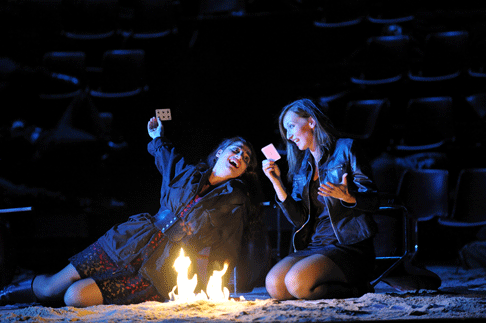19 Jul 2009
Amsterdam: Old Wine in New Bull Rings
A roster of exciting young artists supported by the Concertgebouw Orchestra in the pit, ensured that Amsterdam’s Carmen worked its usual spell.

A roster of exciting young artists supported by the Concertgebouw Orchestra in the pit, ensured that Amsterdam’s Carmen worked its usual spell.
A local favorite in Vienna, Bulgarian mezzo Nadia Krasteva is a rapidly rising star specializing in such roles as Eboli, Ulrica, and Preziosilla (preserved on DVD from Vienna got up in a Dale Evans cowgirl outfit for the “Rat-a-plan”). None of those Verdi ladies is as complex as Carmen, of course, nor do they carry nearly the baggage of audience expectations as does Bizet’s heroine.
Wiggle your hips too much and you are deemed too vulgar, vamp the tenor too much and you are too obvious, do neither and you are too unengaged. There are as many spectators’ opinions on this famous dame as there are fannies in the seats. Miss Krasteva wisely chose a middle road, with a blend of energized, leonine physicality; and a transparent, fatalistic acceptance of her probable demise.
Our mezzo has a fine vocal instrument, with an especially plummy lower range. She also let loose with any number of searing phrases in the upper reaches, and sang with sensitivity and dramatic involvement throughout. Her good sense of line and inexorable build of tension, arguably made the card scene her very finest moment. If she occasionally seemed a little more Italianate than French (Spanish really, but you know what I mean), and if she descended once or twice into ersatz hootchy-kootchy-girl tricks that were not quite derived from the dramatic moment, well, see my paragraph above about ‘damned-if you-do.’ Ms. Krasteva is already a leading proponent of this complicated heroine, and she will only get better as her impersonation matures. Watch for her.
Another wonderful discovery for me was Korean tenor Yonghoon Lee as Don Jose. The boyish Mr. Lee effortlessly looked the dispirited young recruit, which brought into high relief his emotional bond with his mother, and his bedazzlement by Carmen’s sexual allure. Seldom has this seduction seemed so inevitable, or played so well.
His singing was of a very high standard. I don’t know where all that sound comes from out of such a slight frame, but he has ample gold in his full-throated, driving top phrases. Aside from his sizable voice, he has a well-schooled technique, and a well-coached style. There were several astonishingly beautiful uses of voix-mixe, alas, however, not at the end of the Flower Aria (nonetheless, gorgeously sung). Yonghoon acts admirably with his voice and in all vocal moments, he is fully engaged. As he develops, he is sure to loosen up more in his “book scenes” and internalize the dialogue as effectively as he does the vocal line.
 Yonghoon Lee (Don José), Genia Kühmeier (Micaëla), Nadia Krasteva (Carmen)
Yonghoon Lee (Don José), Genia Kühmeier (Micaëla), Nadia Krasteva (Carmen)
I am not sure what eluded me about Genia Kühmeier’s perfectly well-sung Micaela, but there seemed to be a warmth missing from her stage presence, and well, the character is the one that should be nothing but sympathetic. Perhaps it was her rather pristine Mozartean tone and delivery? I have seen this role steal the show entirely, and if she didn’t quite manage that, in fairness, the audience gave her polished performance an enthusiastic ovation.
Kyle Ketelsen made every minute of his stage time count with his swaggering, cock-sure traversal of Escamillo. Mr. Ketelsen is one of those performers who has star presence to spare, and happily he has a resonant, highly-responsive bass instrument that can carry out his intentions very impressively indeed. An imaginative actor, he brings insight and variety to even such a well-known set piece as the “Toreador Song.” It is small wonder that his highly-charged persona turns our mezzo from her troubled soldier boy.
Robert Accurso (Dancairo), Marcel Reijans (Remendado), Renate Arends (Frasquita), and Nora Sourouzian (Mercédès) entertained us mightly in a breathless quintet. While all four contributed solid work throughout, Ms. Sourouzian was especially noteworthy. Nicolas Testé’s pleasing baritone made a fine impression as Zuniga.
Conductor Marc Albrecht led the familiar score with obvious affection, attention to detail, and propulsive fire. It was a true luxury to have an orchestra of the Concertgebouw’s caliber in the pit and they played with sensitivity and commitment.
One US company promoted their Carmen with the hype: “Number One on the Opera Hit Parade.” Yes, it is indeed familiar. Overly familiar? Who can say? But on the premise of familiarity breeding contempt, some producers seek to re-interpret it, or to fit it into a concept, rather than fitting the concept into it.
I have long admired stage director Robert Carsen, who is responsible for several of the very best opera productions I have ever seen. I also find him incapable of doing something that is uninteresting. And “interesting” this show is. As the audience enters the Muziektheater to take their seats, so does the “audience” on stage (aka the chorus members) who assemble randomly in semi-circular, tiered seating upstage, the whole of which embraces a sand-covered bull ring front and center. So far so good.
When the Prelude plays, first the male spectators come down to fill the ring and assume mock macho poses (think SNL’s “We’re gonna pump you up”). Then the female chorus joins them and they get all “sexy.” Oops. So far so bad. Suffice it to say that Act One does not ever substantially improve on this amateurish posturing.
 Nora Sourouzian (Mercédès), Renate Arends (Frasquita)
Nora Sourouzian (Mercédès), Renate Arends (Frasquita)
The soldiers sort of come off as soldiers, but the tobacco workers never do. There is nothing to suggest Seville’s architecture or visually underscore the plot points. There is really not much color at all save the grab-bag of Falk Bauer’s variable costumes. Worse, the performers are directed to tromp up, over, and about these chairs like singing mountain goats. If there was a dramatic motivation for marching down rows of chairs, upending them, sitting in them, or hanging around on the fringes of them, it was lost on me.
This rather dispiriting beginning propelled me to the wine bar at intermission, and perhaps the Merlot had exceptional powers because, well, damn if the rest of the evening didn’t work (and not just “after a fashion”). The stadium (Michael Levine, set design) was still there in the background but a single long row of fluorescent lights was flown in that created a suitably defined playing space for the inn. Indeed, the lighting (design by Carsen and Peter van Praet) that had been blunt and competent in One, began to play a more important role in creating atmosphere and isolating dramatic beats.
The back-lighting of Act Three’s mountain pass (that stadium again with seats scattered and irregular) was downright dramatically galvanizing. By the time we came back to the bull ring in Four, with its every seat now filled by hundreds of extras, it was like we were at whole different quality show. I worried that the final Jose-Carmen encounter might not play in the “ring” but it positively crackled, with the two of them alone in the light and the rest in blackness. And when the chorus suddenly rose in blazing down-light to sing their first interjection, the moment was chills-inducing.
Perhaps all of this would not have worked so well had it not been set up by the foolishness and vagaries of Act One. Perhaps. But to all directors of “familiar” works I say: there is always someone in the audience to whom the work is new. Always. Without having read the synopsis, could a neophyte have begun to understand the first act of this Carmen?
James Sohre